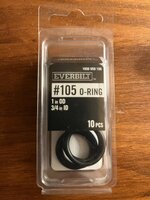At this stage I'll just have to wait to hear back. I've likely tried and checked all that they'll want to know, so I'd say it'll be a matter of the return and wait process (may be a while as I'm overseas).
Hello. Have you made any progress on this issue? I believe I just ran into the same problem, however I am convinced the issue is not the head, but rather the body. I bought an old style md3 body and was using a hound dog xpl head and had very erratic hi/lo operation. I didn't have any issues with 2 other types of new style bodies. I spoke to Gene and he made some suggestions that seemed to help. Taking it a step further and reading more than I ever thought was possible about o-rings, and getting suggestions from other members here, I think I found a plausible solution…
So what Gene suggested was to remove oxidation with high grit sandpaper. I used 400 grit with a layer of rubbing alcohol on a flat surface, and very carefully "wet sanded" the top contact surface until I saw a little material come off. There's no doubt it was oxidized from sitting in a warehouse for a long time. That fixed most of the issues.
He also suggested to use Deoxit Gold on the hi/low contact spring. I Purchased it on Amazon for $7. I do not know what difference this made, but it can't hurt and it was only $7.
DeoxIT® gold Mini-Brush Applicator, 100% Contact Conditioner, 1.6mL - G100L-16BX
https://a.co/d/8acMX70
So, I still had thread wobble when loosened and the yellow Teflon tape made that better, but I do not want to have to replace that every several days as I can't leave things alone, so I will definitely mess with the flashlight and change the heads, Swap batteries (ocd adhd blah blah blah I've heard it all)
So, I ordered 3 types of o rings with a hardness rating of 90 versus the typical 70 which I am waiting to get in the mail.
They have the following measurements:
Inner Diameter: 15/16
Outer Diameter:1-1/8
3/32 cs. I am assuming that means circumference
But while at Home Depot I also grabbed standard off the shelf #105 o rings. No hardness rating details were provided, but they measured:
Inner diameter: 3/4 inch
Outer diameter: 1 inch
Cs:1/8
These work great and make the head almost as tight as if it was wrapped with teflon, but without being wrapped with Teflon. I think the problem with the standard size o-ring that comes from the factory is that they slide when turning the head and these new ones are much tighter, but can still be removed with a plastic pick tool.
Hopefully this helps and it not something you may have already tried.



